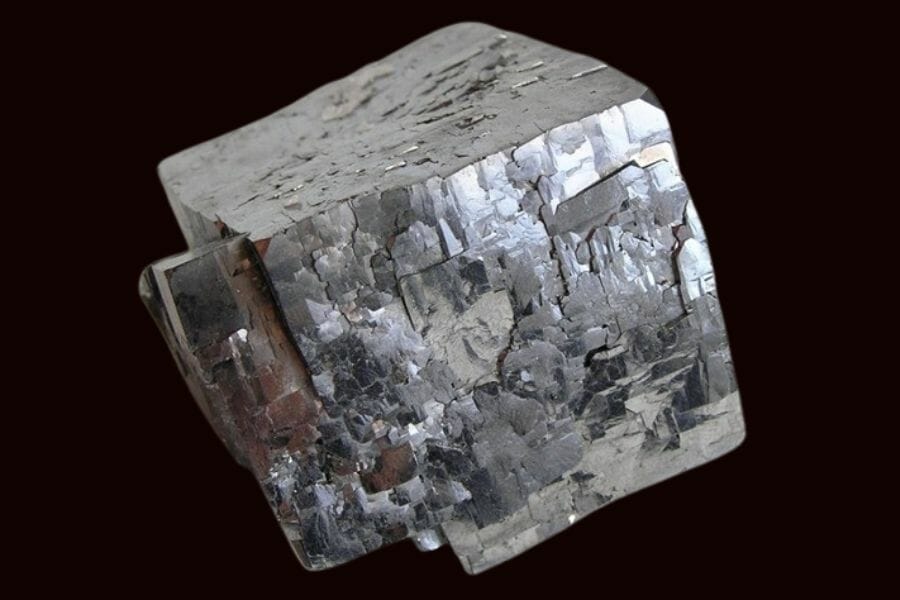Silver is a beautiful and versatile hue that has captured our imagination for centuries. From jewelry and coins, to tableware and decorative objects, this color has been a part of many cultures.
Silver minerals can be found in veins within the Earth’s crust.There are also silver-bearing rocks that glisten with the beautiful luster of silver. Last but not least, silver gems and crystals have been treasured for their beauty and versatility since time immemorial.
Whether you’re a collector, love jewelry and decorative items, or simply curious about the captivating world of silver gems, crystals, minerals, and rocks, this article will give you new insights and knowledge about this lustrous color in nature.
Are you ready to be amazed?
Silver Gems and Crystals
Here are some of the most lustrous silver gems and crystals that will surely captivate your attention when you have the chance to get your hands on them. If you won’t have this chance, we’ve got you covered with their photos, too!
Cassiterite – SnO2
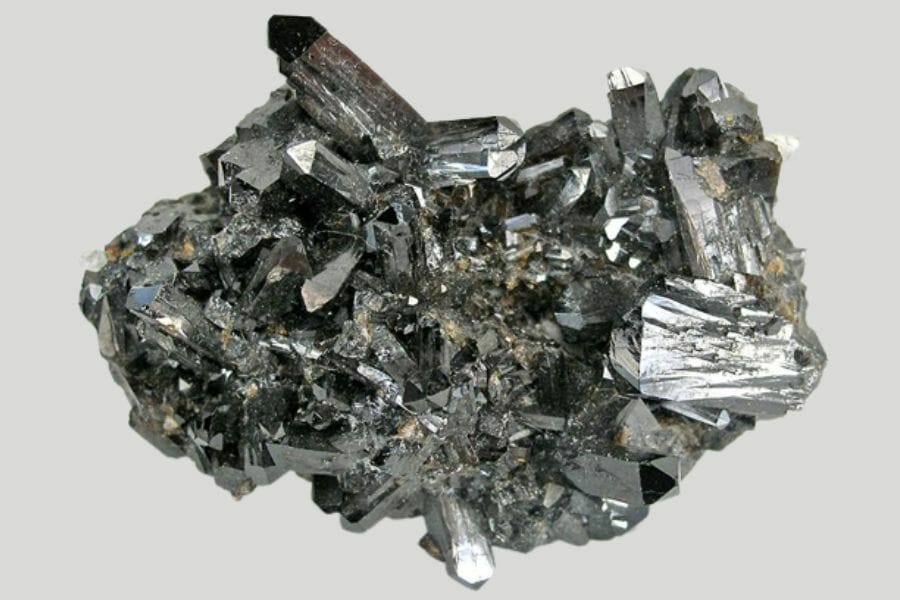
Cassiterite was first mined in the ancient world and has been used for everything— from making bronze and tin objects to being used as a pigment.
In the 19th century, this gem was discovered in large deposits in South America, which led to the development of large-scale tin mining in the region. It continues to be important today, and is still used for making tin alloys and in the electronics industry.
What makes Cassiterite so valuable is its unique combination of properties: it’s hard, durable, and has a high melting point, which makes it well-suited for use in many different applications.
Fun Fact Did you know that Cassiterite is also branded as a "conflict gemstone"? Disputes over Cassiterite deposits, especially in Walikale, have contributed significantly to the ongoing conflict in the eastern regions of the Democratic Republic of the Congo.
Where Cassiterite is found
Cassiterite can be found in tin deposits in China, Brazil, Bolivia, Peru, Malaysia, Thailand, and Australia. It can be found in vein deposits and as a placer deposit, in streams and rivers. Cassiterite can also be found in hydrothermal deposits, skarns, and greisens. Simply put, it’s found in various geological environments, which gives it a wide distribution.
How you can identify a Cassiterite
- Color: Cassiterite’s color can vary, but it’s mostly a brown, blackish brown, or silver. Its metallic luster is one of the key characteristics that makes it easily distinguishable from other gems.
- Hardness: Cassiterite is relatively hard, with a Mohs hardness of 6-7. It can withstand wear and tear and weathering. However, its hardness can also make it a challenge to cut and polish.
- Clarity: Cassiterite is a translucent to opaque gem, which means it allows some light to pass through it, but it’s not completely transparent. It can vary depending on the presence of impurities and the type of mineral inclusions.
- Refractive index: The refractive index of Cassiterite is 2.05-2.08, which is relatively high. This gives it a bright and sparkling appearance, making it a visually striking gem.
- Specific gravity: Cassiterite has a specific gravity of 7.0-7.1, making it a heavy gem. Its high specific garvity is a crucial property that contributes to its usefulness in various industrial applications.
Cobaltite – CoAsS
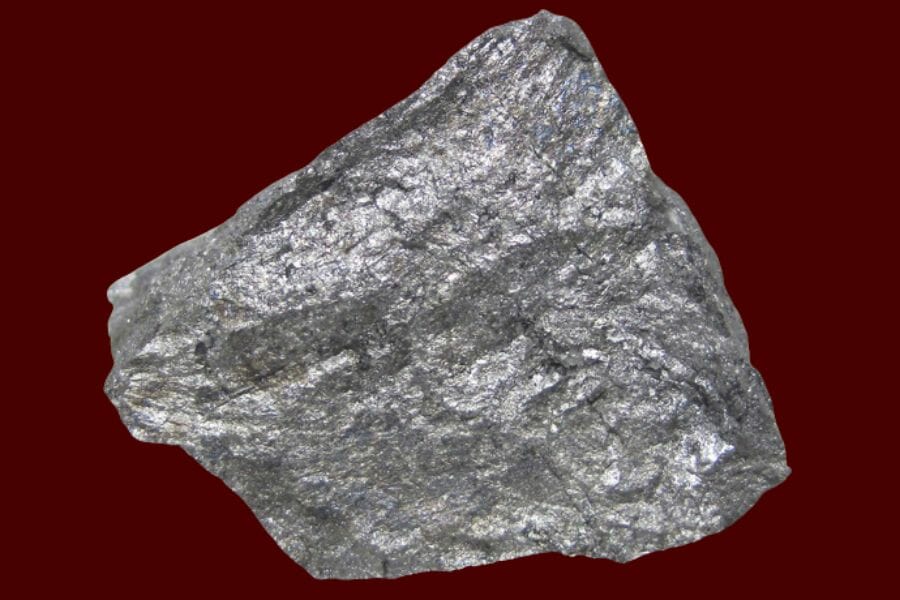
Cobaltite has been valued for centuries for its unique properties and versatility. It was first discovered in the 18th century and has since been used in a variety of applications, from jewelry to electronics.
Cobaltite is prized for its ability to conduct electricity. It’s a major source of cobalt, a key component in the production of high-strength alloys and batteries. It’s also used in the production of pigments and catalysts.
Cobaltite is also highly valued by gem collectors and enthusiasts for its unique appearance and rarity. It has a unique set of physical and chemical properties that make it highly sought after by mineralogists and geologists.
Fun Fact
Cobaltite is one of the few gems that changes color when exposed to different lighting conditions. This is due to the presence of cobalt ions, which can absorb light in different ways depending on the light source. This property makes it a fascinating gem to observe and collect!Where Cobaltite is found
Cobaltite is found in various parts of the world, primarily in European countries such as Sweden, Norway, and Germany. It’s also found in smaller quantities in North America, Africa, and Asia. Cobaltite is typically found in hydrothermal veins, in nickel-cobalt-arsenic deposits, and in some cobalt-rich sulfide deposits.
How you can identify a Cobaltite
- Color: Cobaltite’s color can vary, but it’s typically silver-grayish. Sometimes it can also have a blue-greyish or blackish tint. This is due to the presence of cobalt ions, which gives it its distinctive coloration.
- Hardness: Cobaltite has a moderately high hardness, with a Mohs scale rating of 5.5 to 6. This makes it resilient, but also difficult to work with when cutting or polishing.
- Clarity: Cobaltite has a shiny and reflective appearance, but it can also have a somewhat dull or opaque appearance in some cases. Its clarity can vary depending on the presence of impurities or inclusions.
- Refractive index: The refractive index of Cobaltite is moderately high, with a value of around 2.1 to 2.3. This results in a bright and sparkling appearance, as it reflects light in a way that enhances its metallic luster. It’s one of its optical properties that makes it a fascinating gem to study.
- Specific gravity: The specific gravity of Cobaltite is 6.0 to 6.5, which is moderately high. This is due in part to its metallic composition. Because of this, Cobaltite has a heavy feel in the hand.
Hematite – Fe2O3
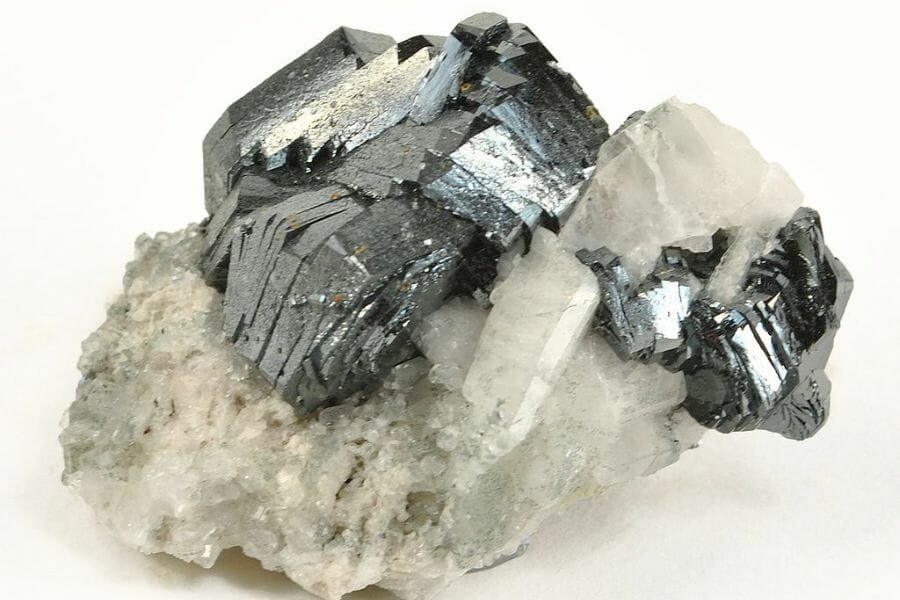
Hematite has a long history of use as a pigment, decorative stone, and source of iron. It has a unique crystal structure and chemical composition that give it a metallic luster.
Throughout history, Hematite has been used for many purposes. It was used as a pigment in cave paintings and rock art and as material for jewelry and other decorative items. More recently, it’s been used as a source of iron for industrial purposes, making it an important gem.
Hematite is also valued for its beauty and versatility. It’s a popular choice for jewelry and decorative items. It’s also considered to have spiritual and healing properties in many cultures, adding to its overall value and popularity.
Fun Fact Hematite has been discovered on Mars, with the Mars Global Surveyor detecting huge amounts of the gem close to the planet's equator in 1998. This discovery even suggested the possibility of water having once existed on Mars!
Where Hematite is found
Hematite is found in metamorphic rocks, such as banded iron formations and also in sedimentary rocks, such as red sandstones and shale. Hematite is a widespread gem that’s found on every continent. It’s often found in deposits near hot springs and volcanic regions.
How you can identify a Hematite
- Color: Hematite’s color can range from deep, dark red to a lighter, silver-gray. It’s luster is metallic, giving it a reflective quality. Its color is due to its high iron content and can vary based on the lighting, angle, and even surrounding gems and minerals.
- Hardness: Hematite is a relatively hard mineral, with a hardness of 5.5-6.5 on the Mohs scale. It’s relatively hard, but can still be scratched or damaged if exposed to abrasive materials or pressure.
- Clarity: Hematite has variable clarity, ranging from transparent to opaque. It depends on the size and arrangement of the sample’s crystal structure, as well as the presence of inclusions or impurities.
- Refractive index: Hematite has a refractive index of 2.9-3.0, which is considered moderate for a gem.
- Specific gravity: Hematite’s specific gravity is 5.3-5.6, which is relatively high due to its high iron content. This makes it useful in industry and jewelry, as well as a heavy filler in various applications, such as in paint & ceramics.
Marcasite – FeS2
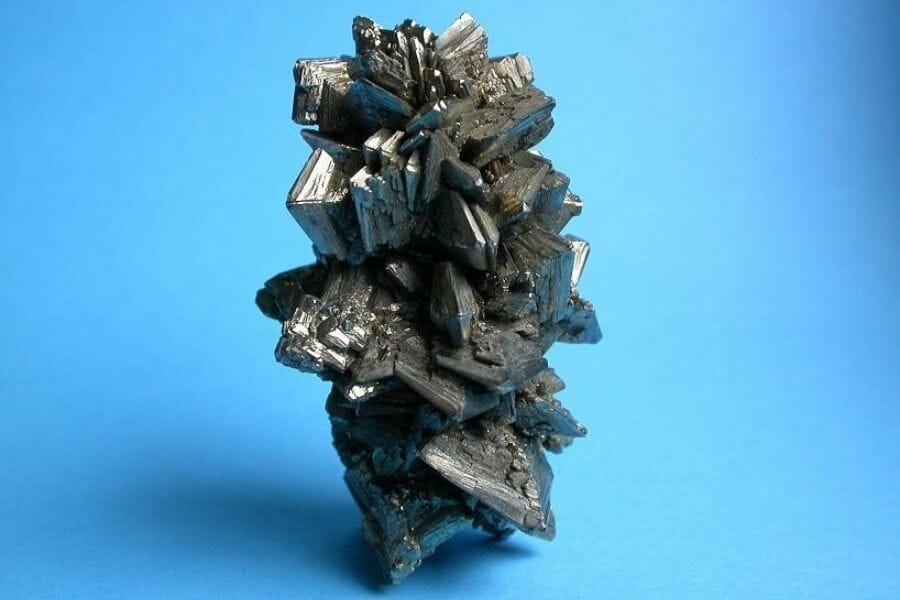
Marcasite, also known as white iron pyrite, has been used for thousands of years for its ornamental value. It has been found in jewelry and decorative objects dating back to ancient times.
In the Middle Ages, Marcasite was used to make sulfuric acid, which was a crucial component in the production of fertilizers, paper, and textiles. It’s often used in place of gold and silver, especially during times of war or economic hardship when those metals were in short supply.
In recent years, it has been increasingly used for its unique properties and attractive appearance. It’s valued by gem collectors and enthusiasts, who appreciate its rarity and beauty.
Fun Fact Have you ever heard or read about "Pyrite Decay"? It's the term used for the breakdown of Marcasite in a collection. This happens when it reacts with the humidity and oxygen in the air. Keeping your samples in conditions of low humidity (preferably below 60%) can prevent or slow down this reaction.
Where Marcasite is found
Marcasite is found in different parts of the world, mainly in Europe, Asia, and America. It’s also found in coal and shale deposits and in metamorphic rocks like schist and gneiss. Some well-known locations for Marcasite include France, Germany, England, and the USA, specifically in states like Missouri and Utah.
How you can identify a Marcasite
- Color: Marcasite is usually a pale brass-yellow color with a metallic silver luster, depending on the impurities present in it. Its unique, brassy luster makes it easily recognizable and distinguishable from other gems.
- Hardness: Marcasite’s hardness ranges from 6-6.5 on the Mohs scale, which means it’s quite durable but can still be scratched with ease by harder gems. It’s somewhat brittle and prone to breakage in certain cases.
- Clarity: Marcasite is usually translucent or opaque in clarity. Its crystal structure is often obscured by its dullness or tarnishing, so you can’t see through it clearly.
- Refractive index: Marcasite’s refractive index is between 2.0-2.3, which is on the lower bracket. This contributes to its low luster and light reflectivity. It can also sometimes be used to differentiate Marcasite from other gems that may resemble it, like pyrite.
- Specific gravity: Marcasite’s specific gravity is around 4.8 to 4.9, which is relatively light. It’s less dense than pyrite, which it’s often mistaken for.
Leucite – KAlSi2O6
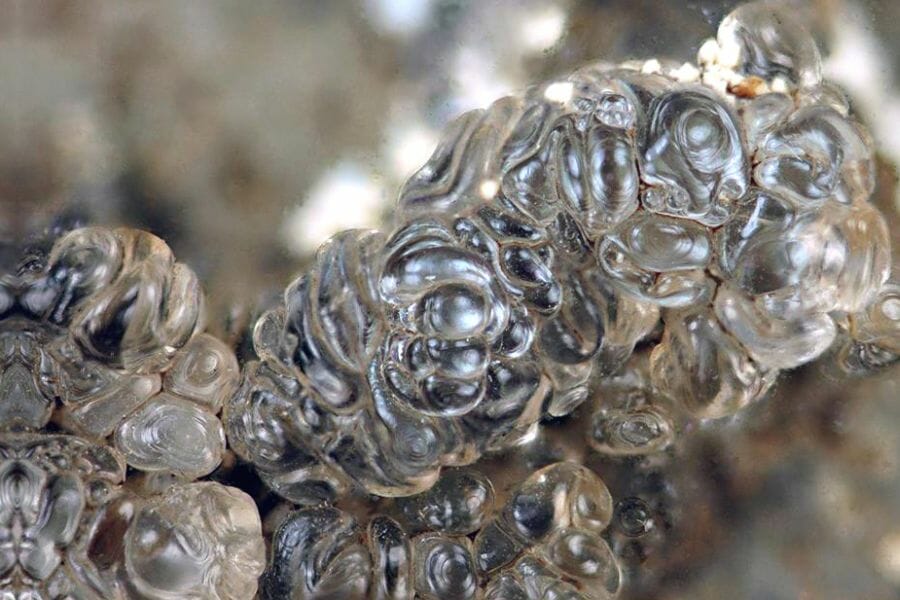
Leucite was first described by the Roman naturalist Pliny the Elder in the 1st century AD, who wrote about its occurrence in volcanic rocks. It’s a potassium-rich gem that’s often associated with feldspar, amphiboles, and biotite.
This gem has a glassy or pearly luster and it often forms distinctive, aggregated crystals that are highly prized by gem collectors.
In ancient times, Leucite was used as a decorative stone and as an ingredient in the production of glass. In the 18th and 19th centuries, it was used as a source of potash, a key ingredient in the production of fertilizers, soap, and other products. More recently, it has been used as a raw material in the production of ceramics, glass, and electronics.
Fun Fact If you have a dental crown, braces, or veneers, then you have Leucite in your mouth! That's right. Leucite is a major component in dental porcelains.
Where Leucite is found
Leucite is found in Italy, Russia, Iceland, and the US. It’s most notably found in the Tuscany region of Italy, where large deposits of Leucite have been discovered in volcanic rocks. It also occurs in some other volcanic rock types, such as phonolite and trachyte, as well as in some types of alkaline intrusive rocks.
How you can identify a Leucite
- Color: Leucite’s typically colorless or white, with a slight tint of metallic silver, yellow, gray or pink. It doesn’t typically exhibit any notable color zoning or patterns, which makes it distinctive from other gems.
- Hardness: Leucite has a hardness of 5-5.5 on the Mohs scale. It’s relatively soft and it can be scratched or damaged easily. On the positive side, its softness makes it useful for carving and sculpting.
- Clarity: Leucite can be transparent or translucent. Its clarity depends on the presence of inclusions or internal fractures. It doesn’t typically exhibit any significant cloudiness or opaqueness, which makes it a relatively clear gem.
- Refractive index: Leucite has a refractive index of 1.485-1.493, which is relatively low. This is particularly useful in optical fibers, where it’s used to reduce the amount of light lost as it travels along the fiber.
- Specific gravity: Leucite’s specific gravity is 2.48-2.51, which is relatively low, making it less heavy and less dense. This property of Leucite can be affected by its impurities.
Silver Rocks
Believe it or not, there are also a number of cool, silver rocks that are waiting to be found! Below are some of them for you to enjoy reading about.
Anthracite – C15H11O
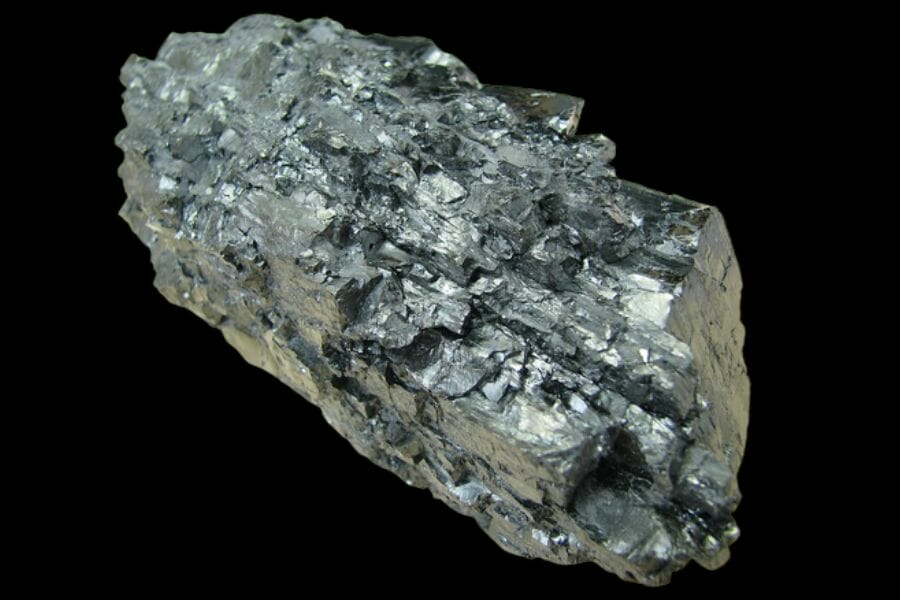
Anthracite, a high-quality type of coal, is prized for its high energy content and low levels of impurities. It’s discovery in Pennsylvania was a turning point in the American industrial revolution, as Anthracite was essential for powering the factories and steam engines of the time.
Anthracite has since been widely used as a fuel source, both for residential heating and industrial purposes. In recent years, it has become increasingly valuable due to its scarcity and reputation as a premium fuel source.
Its use has declined in many countries, as other energy sources have become more prevalent, but Anthracite remains an important fuel source in some regions, particularly in Asia.
Fun Fact Anthracite is a naturally smokeless fuel! For about 50 million years longer than bituminous coal, Anthracite was exposed to intense heat and pressure during coalification, resulting in a very low sulfur content and virtually no volatile components. This makes it a clean-burning fuel that produces little to no smoke. How amazing is that?
Where Anthracite is found
Anthracite is found in several regions of the world, such as in North America, Russia, South Africa, and Australia. It’s also found in smaller deposits in several other countries. The largest deposits are found in Pennsylvania, USA which once was the world’s top producer of Anthracite.
How you can identify an Anthracite
- Color: Anthracite is a dark, nearly black coal with a silver metallic luster. Its high carbon content gives it its distinctive dark color.
- Hardness: Anthracite is known to be a very hard coal due to its high carbon content. Its hardness makes it a popular fuel source for heating and industrial purposes, as it’s able to burn hot and long without producing much ash.
- Clarity: Anthracite is characterized by its glossy and opaque appearance. As a type of coal, it’s doesn’t have clarity, but it does have a metallic luster.
- Refractive index: Anthracite’s refractive index varies based on the type and size of sample, but it’s usually between 1.6 to 2.0.
- Specific gravity: The specific gravity of Anthracite ranges from 1.3-1.5, which is higher compared to other types of coal due to its low sulfur and high carbon content. Because of this, it burns more efficiently, producing a hotter and longer-lasting fire.
Mica Schist
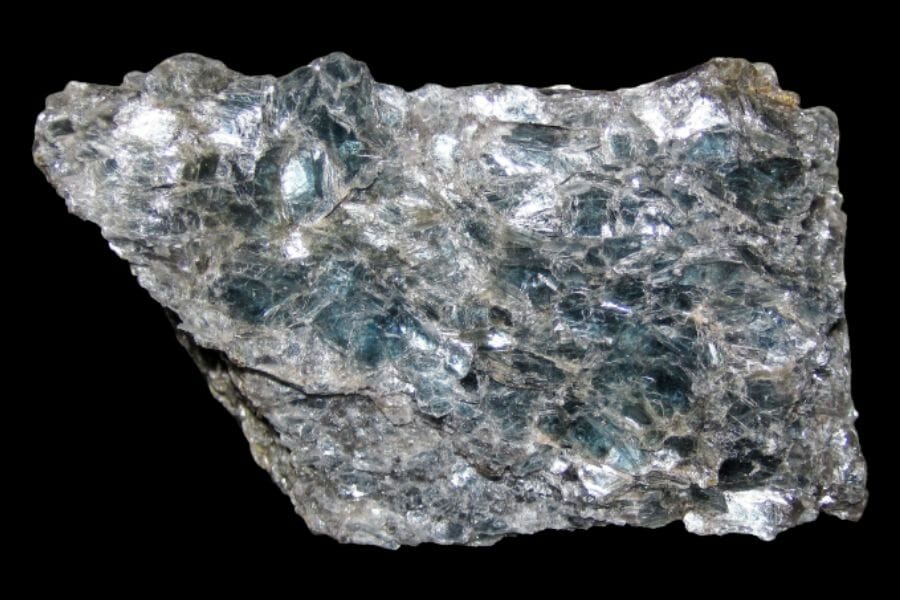
Mica Schist is a type of metamorphic rock that’s characterized by its distinct layered appearance and shiny mica crystals. The shiny Mica crystals in this rock have been used for ornamental purposes, such as in jewelry and decorative items, while the rock itself has been used as a building material for centuries. The rock’s layers are often split apart and used for roofing shingles, floor tiles, and walls.
Mica schist was also used by ancient civilizations as a writing surface, due to its flat and durable nature. Today, it’s still valued for its various uses. It’s used in the oil and gas industry for drilling purposes due to its ability to withstand high pressure and temperature conditions.
Overall, Mica Schist is a versatile and valuable rock that has been used throughout history and continues to play a role in our modern world.
Fun Fact Did you know that Mica Schist was used in the construction of Stonehenge, one of the most famous prehistoric monuments in the world? The rocks used in Stonehenge were transported from a quarry in Wales, where Mica Schist was abundant. How cool is that?
Where Mica Schist is found
Mica Schist is found in many regions, such as South & East Asia, Europe, North America, and are widely distributed globally. These rocks are formed by metamorphic processes in various tectonic settings, such as in collision zones between continents, volcanic island arcs, and within large mountain ranges. Specifically, they’re common in ancient mountain belts where rocks were subjected to high-pressure and high-temperature conditions.
How you can identify a Mica Schist
- Color: Mica Schist’s color is usually grayish-green, grayish-black or silver-gray with a shining surface. The presence of iron oxide minerals gives it a rusty hue in places. It appears dull as it’s usually composed of tightly-packed mica minerals.
- Hardness: Mica Schist has a moderate hardness between 2-4 on the Mohs scale. It’s relatively soft compared to other metamorphic rocks, but still can’t be scratched with a fingernail. It’s durable enough to be used in flooring, countertops, and as building material.
- Clarity: Mica Schist’s clarity is generally translucent to opaque, depending on the amount of mica, clay, and other minerals present in the rock. Its overall appearance can range from hazy to relatively clear, but it’s usually not crystal clear.
- Refractive index: Mica Schist’s refractive index isn’t well-defined, but the mica mineral which is abundant in this rock has an average refractive index of 1.56-1.57.
- Specific gravity: Mica Schist’s specific gravity is typically 2.5-2.9 (g/cm^3), so it’s considered a medium-light weight rock.
Shale
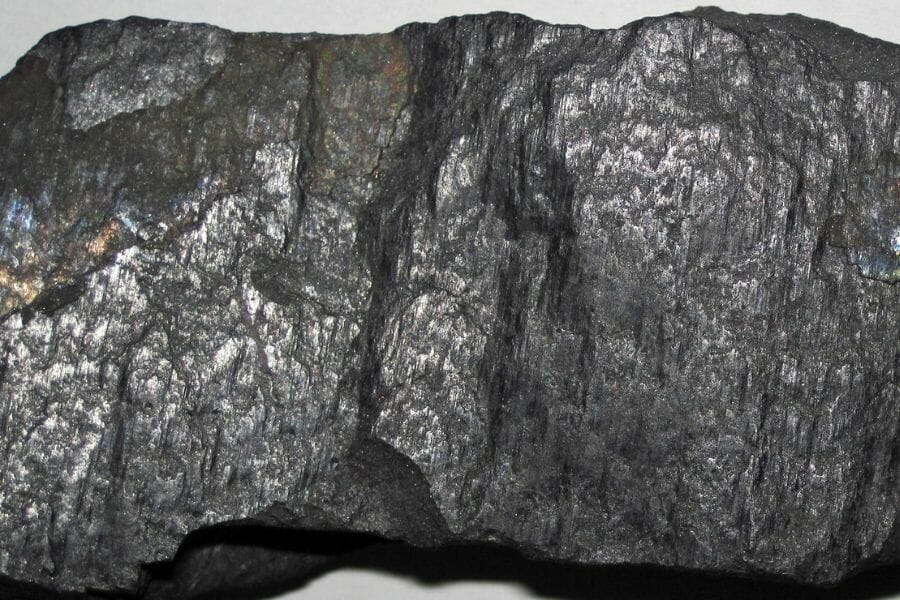
Shale is a sedimentary rock composed mainly of clay minerals, silt, and organic matter. It’s been around for over 300 million years and is abundant in many parts of the world.
Shale’s been used in many ways and has played a big role in human history. The ancient Romans used it to make roof tiles, while Native Americans used it to make pipes and pottery. In the 19th century, Shale oil was discovered and has since become a valuable energy source. It’s also used as a construction material and in the production of cement and bricks.
Shale is valued for its versatility and affordability. It’s low cost and abundant supply make it a popular choice for many industries and building projects.
Fun Fact Shale is the most abundant type of sedimentary rock on the Earth's surface! In fact, it comprises 70% of this rock type in the world. Such a globetrotter!
Where Shale is found
Shale can be found all over the world, from the U.S. to Europe to Asia, in various sedimentary rock formations. It’s most common in areas with a history of shallow oceans or lakes, where fine particles of sediment settle and eventually become compacted into rock. Shale is also found in areas that have undergone intense geological pressure and heat, like mountain ranges.
How you can identify a Shale
- Color: Shale has a variety of colors, depending on the minerals present in it and the location it’s found. Common shale colors include silver-gray, black, green, brown, and red.
- Hardness: Shale’s hardness is in the range of 2 to 4 on Mohs scale. However, it can also be softer (1.5) or harder (5) in certain regions. Its hardness is due to its composition, which can vary greatly and include minerals such as clay, quartz, feldspar and calcite.
- Clarity: Shale is mostly opaque with a dull, earthy appearance. But, sometimes if it’s thin enough, you can see some light passing through it, making it appear slightly translucent.
- Specific gravity: Shale’s specific gravity varies depending on its composition, but it’s generally considered low to medium, ranging from 2.0 to 2.6 g/cm³.
Graphite – C
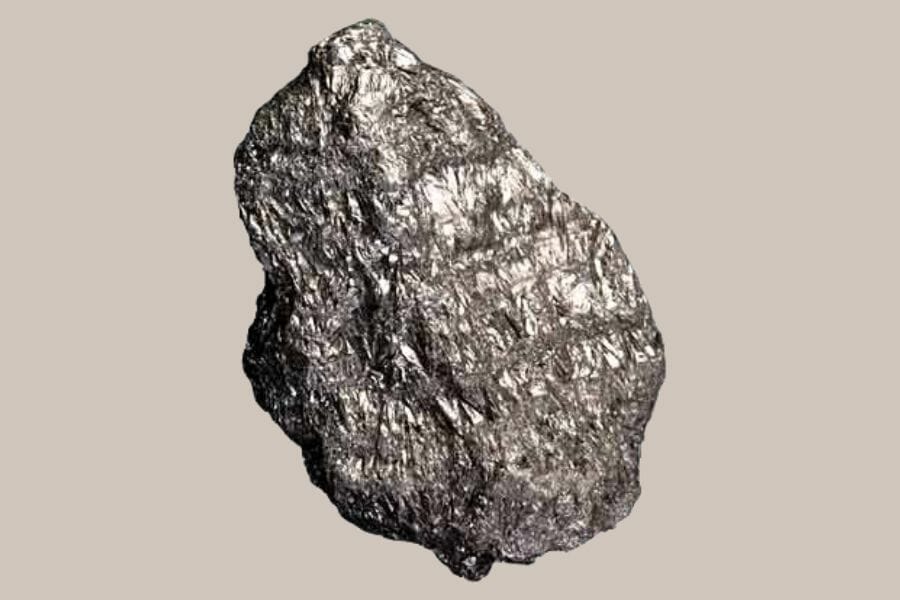
Graphite was first discovered in Ceylon (modern-day Sri Lanka) in the late 16th century. It was initially used in making pencils, but its uses have greatly expanded since then.
Graphite’s unique properties have made it a valuable material in many industries. It’s used in the production of batteries, as a lubricant, as a moderator in nuclear reactors, and even in the making of fireproof materials. In the 20th century, the increased demand for high-temperature furnace linings and crucibles led to increased mining and production of Graphite.
This rock’s market value rose due to its scarcity. While it’s widely distributed everywhere, high-quality Graphite is difficult to find and the process of mining and refining it is complex and expensive. This, combined with its versatile properties, has made it one of the most valued rocks today.
Fun Fact Did you know that Graphite is so awesome, it is actually the only non-metal material that can conduct electricity? Talk about versatility!
Where Graphite is found
Graphite is found in many parts of the world, including Canada, China, Brazil, India, and the US. It’s formed when carbon is subjected to high pressure and temperature over time, so it’s usually found in metamorphic rocks and some sedimentary rocks. Graphite deposits are often found near granite bodies or in areas where volcanic activity has taken place. It can also be found in organic-rich shale formations.
How you can identify a Graphite
- Color: Graphite’s color is typically gray or black, sometimes with a silver metallic luster. Just look at the photo above! Some samples may also appear blue or green because of impurities.
- Hardness: Graphite’s hardness is 2-2.5 on Mohs scale, which is considered soft. Its softness allows it to be used as a lubricant, but can also make it brittle, causing it to break or crumble easily.
- Clarity: Graphite is an opaque rock, so light cannot pass through it and it appears completely dark. This characteristic is due to its high carbon content.
- Refractive index: The refractive index of Graphite is low and it doesn’t allow light to pass through it.
- Specific gravity: Graphite has a specific gravity of 2.2 to 2.3, which is relatively low. This means it’s lightweight and has a low density due to its hexagonal molecular structure and its bonds that are arranged in sheets, allowing for spaces between it.
Phyllite
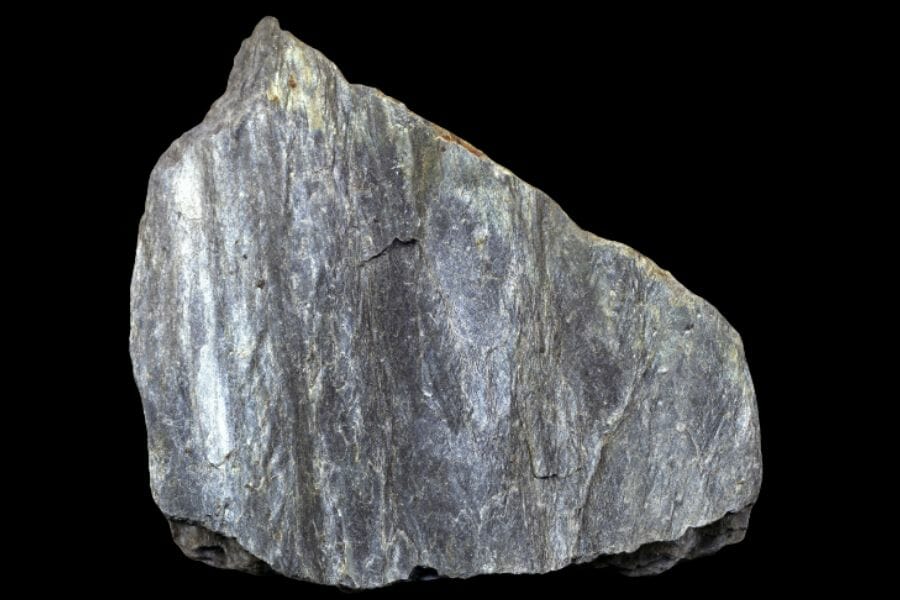
Phyllite is a metamorphic rock that’s thought to have formed from shale or mudstone, through processes of pressure, heat, and shearing. Its name comes from the Greek word “phyllos,” meaning “leaf,” due to its leaf-like appearance in thin section.
Phyllite has been used as a building stone in various parts of the world, including Europe, South America, and Asia. It’s also often used as a decorative rock in landscaping, and its fine-grained texture and shiny appearance make it popular for use in countertops and flooring
The value of Phyllite is largely due to its distinctive appearance, which sets it apart from other types of rocks. It’s known for its shiny, silky surface and layered, foliated appearance.
Fun Fact Interestingly, Phyllite's versatility benefits humans until their death. How? Among the other commercial uses of Phyllite is for cemetery markers and commemorative tablets in cemeteries.
Where Phyllite is found
Phyllite can be found all over the world in regions that have undergone tectonic activity and mountain building processes. It’s particularly abundant in areas of ancient mountain ranges, like the Appalachian Mountains in the eastern U.S., the Scottish Highlands, and the Swiss Alps. Phyllite is also commonly found in areas that were once part of ancient supercontinents, like the Gondwana supercontinent in the southern hemisphere, which included present-day Africa, South America, Australia, and Antarctica.
How you can identify a Phyllite
- Color: Phyllite is usually gray, silver, green, black, or brown in color. Some variations may have a reddish or yellowish hue. It can also have a dull to shiny appearance, depending on its level of metamorphism and mineral composition.
- Hardness: Phyllite’s hardness can vary, but generally falls between 2 and 4 on the Mohs scale. This makes it a relatively soft rock that can easily be scratched with a fingernail.
- Clarity: Phyllite has a dull luster, which means it doesn’t reflect much light. It often appears hazy, cloudy or milky due to the presence of fine mica minerals, which scatter light. It also often contains finer-grained minerals which can further affect its clarity.
- Refractive index: Phyllite’s refractive index is typically around 1.5 to 1.6, which is considerably low. This means that light doesn’t bend much as it passes through it, making it look less clear or transparent.
- Specific gravity: Phyllite’s specific gravity can range from 2.7 to 2.9 g/cm³, which is considered a medium density. It has a distinct feel when handled, but is still relatively lightweight compared to other types of rocks.
Silver Minerals
Beauty, purpose, and durability— these are some only of the amazing characteristics the following lustrous silver minerals possess.
Galena – PbS
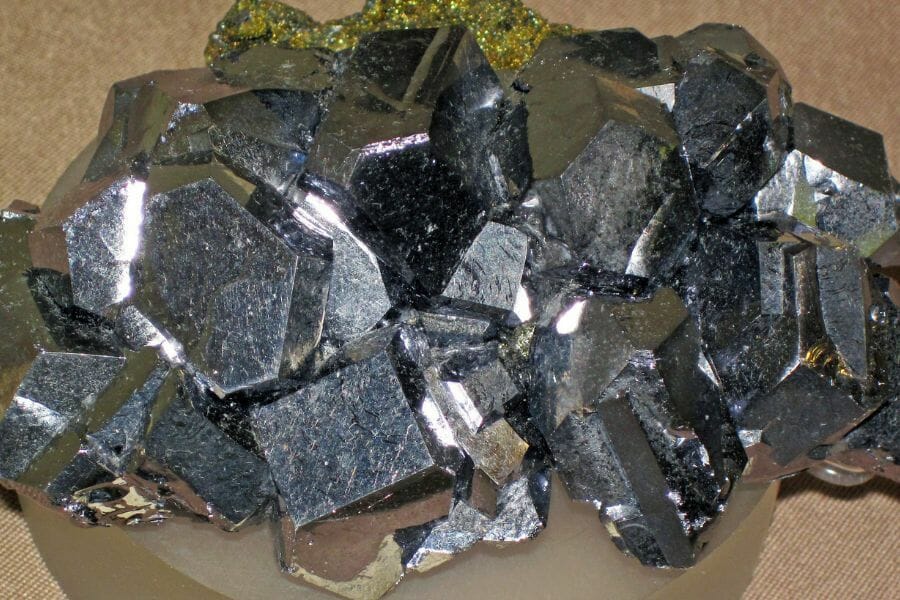
Galena was first used in ancient times as a pigment in paint and makeup. It was also believed to have medicinal properties. The Ancient Egyptians, for example, believed that it could cure a variety of ailments.
One of the key reasons Galena is valued is due to its high lead content. Lead was widely used in ancient times for a variety of purposes, including making pipes, weights, and even coins. It’s still used in some applications today, such as in batteries and radiation shielding.
Galena is also valued for its complex structure that features long, narrow, needle-like crystals that can be up to several inches in length. This makes it an interesting mineral for collectors and geologists, and it’s also one of the reasons why Galena is used in scientific research.
Fun Fact Twenty (20) years before the California "Gold Rush", there was first a "Lead Rush" that centered on mining Galena for its valuable lead content.
Where Galena is found
Galena can be found in many different types of deposits, including vein deposits, sedimentary deposits, and as replacements in limestones and dolomites. Some of the major Galena producing countries are China, Australia, U.S (Missouri, Oklahoma, and Kansas), Russia, Mexico, Germany, Ireland, and England. It can also be found in several African countries including Morocco and South Africa. In South America, it’s found in countries such as Peru, Chile, and Argentina. Overall, Galena is a widespread mineral!
How you can identify a Galena
- Color: Galena is often found in shades of lead gray, blacking gray, or silver color. It can also have a metallic luster with a dull, black streak. Its color can vary depending on the presence of impurities.
- Hardness: Galena’s hardness varies, but it’s generally considered soft, ranging from 2 to 2.5 on the Mohs scale. It can be scratched easily by a fingernail.
- Clarity: Galena is opaque, so it doesn’t allow light to pass through it. It has a distinctive, silver metallic luster, so when polished, its surface becomes reflective.
- Refractive index: Galena’s refractive index is moderate, with a value ranging from 2.4 to 2.6. This is typical for minerals with metallic luster, and contributes to its distinctive appearance and uses in industry.
- Specific gravity: Galena has a specific gravity of 7.5-7.6, which is relatively high for minerals. It’s heavy for its size, making it easily distinguishable from other minerals.
Stibnite – Sb2S3
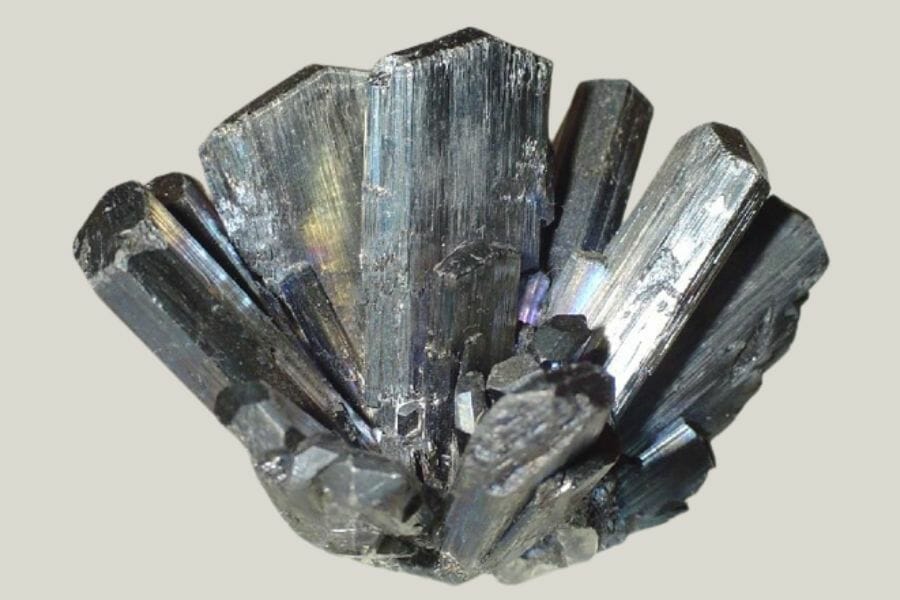
Often found in the form of elongated, curved, or columnar crystal formations, which add to its unique appearance, Stibnite has been used in a variety of ways.
In Chinese traditional medicine, for example, this mineral was used to treat certain illnesses. Meanwhile, the ancient Egyptians also used it to create the black cosmetic kohl.
Stibnite is a great source of antimony, a metal used in alloys and in fireproofing materials. In recent years, the demand for antimony has increased due to its use in modern technology, leading to increased exploration and production of Stibnite worldwide.
Fun Fact Throughout history, Stibnite has been used in the production of matches, fireworks and percussion caps. Such fire in one mineral!
Where Stibnite is found
Stibnite is found in many countries, including China, Italy, Peru, Morocco, Mexico, and the US. It’s usually located in low-temperature hydrothermal veins and near volcanic exhalations. It’s also often found near sulfide minerals like pyrite, chalcopyrite, and sphalerite.
How you can identify a Stibnite
- Color: Stibnite has a dark, metallic gray or silver color. It may appear black or slightly shiny due to its high lead content.
- Hardness: Stibnite has a hardness of 2-2.5 on Mohs scale, making it a soft mineral that can easily be scratched with a fingernail. Its softness also makes it prone to breaking or bending, so it must be handled carefully.
- Clarity: Stibnite’s clarity can be clear or opaque, depending on the impurities present in the mineral. However, its high-quality specimens often display a distinctive silvery sheen or metallic luster.
- Refractive index: Stibnite’s refractive index is low, which means it does not refract, or bend light to a great degree. It falls in the range of 1.50-1.70.
- Specific gravity: Stibnite’s specific gravity is around 4.0-4.5, so it’s a little heavy for its size. It’s metallic luster causes its high density.
Arsenopyrite – FeAsS
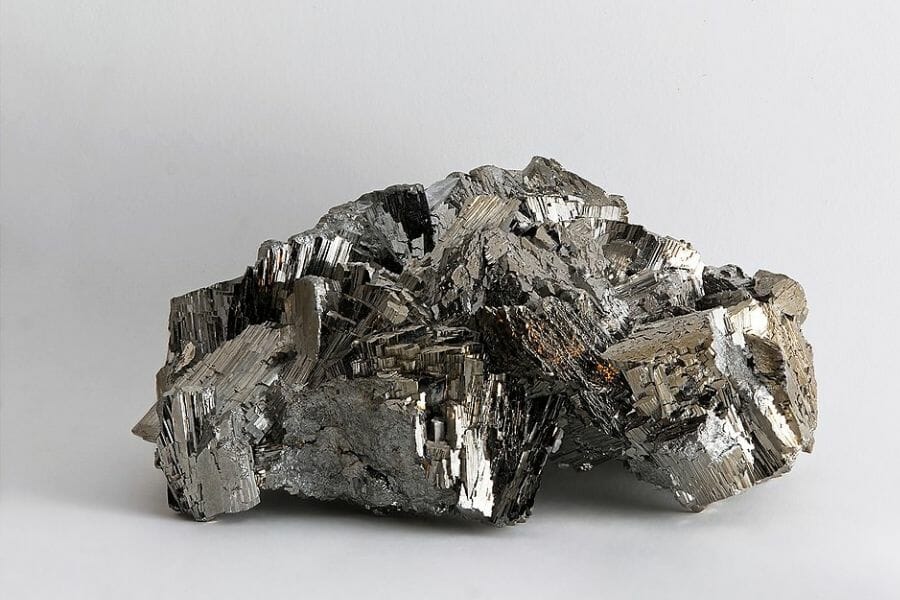
Arsenopyrite was first discovered in the late 1700s and was named after its chemical composition, arsenic and pyrite. Throughout history, it has been used in a number of different applications.
One of the reasons that Arsenopyrite is valued is because of its high sulfur content, which is a critical component in the production of sulfuric acid, a widely used chemical in many industries. It is also a good source of iron and other valuable minerals, making it an important mineral for the mining industry. Lastly, it has also been used as a decorative mineral.
Despite its use, the production of arsenopyrite is limited due to the dangers associated with arsenic exposure and the need for specialized equipment to extract this mineral safely.
Fun Fact: In older literature, Arsenopyrite is also called, "Mispickel" which is of German origin. So if you ever read a book that uses this name for a mineral, just know that its referring to Arsenopyrite.
Where Arsenopyrite is found
Arsenopyrite is found in several countries around the world, including the US, Russia, South Africa, Australia, and Chile. It’s commonly found in hydrothermal veins and skarn deposits, as well as in some copper, lead, and gold deposits. Arsenopyrite can also be found in some low-temperature hydrothermal deposits, like those in sedimentary rock-hosted deposits.
How you can identify an Arsenopyrite
- Color: Arsenopyrite is known for its silvery-grey color, with color intensity ranging from a light silver to a darker gray. It often has a metallic sheen to it.
- Hardness: Arsenopyrite’s hardness is 5.5-6 on the Mohs scale, which is considered moderately hard. It is able to scratch glass and other minerals of equal or lower hardness.
- Clarity: Arsenopyrite’s clarity can vary, but generally it is opaque to translucent. It often has a metallic luster and a pearly to sub-metallic appearance. Some specimens can have a bright, metallic sheen, while others may appear dull.
- Refractive index: Arsenopyrite’s refractive index is usually around 2.8 – 2.9. This is considered to be low, so light passes thru it slowly, giving the mineral a somewhat opaque appearance.
- Specific gravity: Arsenopyrite’s specific gravity is around 5.9-6.2, which is heavy. Its high density can help distinguish it from other minerals with similar appearances.
Tetrahedrite – (Cu,Fe) 12Sb 4S 13
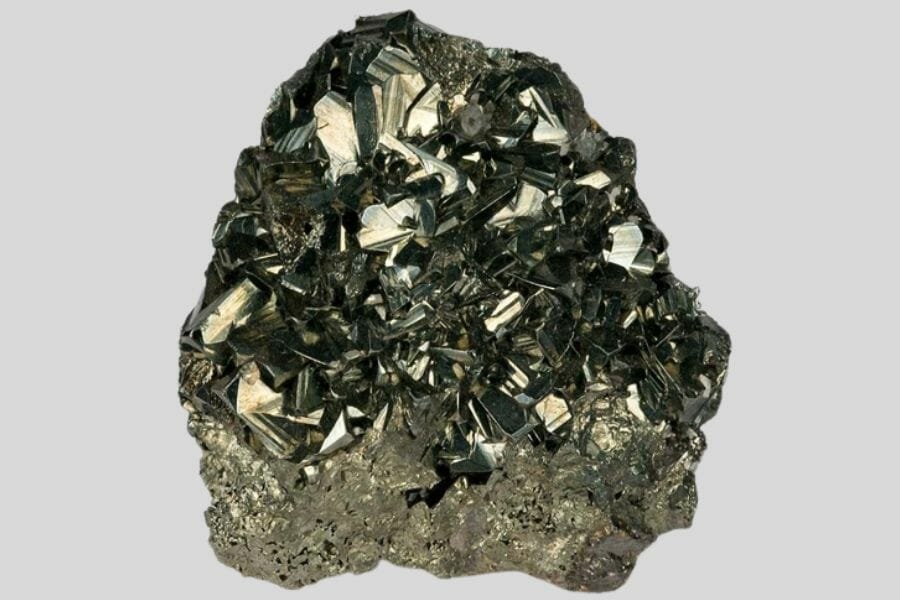
Tetrahedrite was first discovered in the late 1700s. It’s a sulfosalt that can be found in many different parts of the world, and it’s valued for its unique properties, including its distinctive crystal structure and its high copper content.
In the past, Tetrahedrite was used as a source of copper. Over time, it was discovered that Tetrahedrite also contained significant amounts of silver and other metals, making it even more valuable.
Despite its high value, Tetrahedrite is still considered to be a relatively common mineral, and it is found in many different types of rock formations, including copper-silver deposits and sulfide ore deposits. In recent years, it has also become popular for collectors and enthusiasts, who appreciate its unique beauty and interesting history.
Fun Fact Tetrahedrite has a unique crystal structure, consisting of tiny tetrahedrons arranged in a stacked formation. This structure is thought to contribute to its exceptional electrical conductivity, making it an interesting mineral for scientific study.
Where Tetrahedrite are found
Tetrahedrite is primarily found in copper and silver mines, as well as other metal-rich deposits. It’s widely distributed across the world, with notable large deposits in Europe, North America, and parts of Asia. It’s a common mineral in copper-mining areas, and is often associated with other copper-sulfide minerals such as chalcopyrite, sphalerite, and enargite.
Tetrahedrite is a secondary mineral, which means it forms from the alteration of other minerals in the presence of fluids and gases. It’s been found in a variety of environments, including high-temperature hydrothermal deposits and low-temperature sedimentary deposits.
How you can identify a Tetrahedrite
- Color: Tetrahedrite is usually a metallic grey or silver color, with hints of brass yellow. It can also sometimes have a slightly iridescent or tarnished appearance. Its color is due to the presence of copper and other metals in its composition.
- Hardness: Tetrahedrite has a hardness of 2.5 to 3 on the Mohs scale. It’s a relatively soft mineral that can be scratched or damaged easily. Despite its softness, it’s still durable enough to maintain its structural integrity in various geological environments.
- Clarity: Tetrahedrite’s clarity varies from opaque to translucent. Its translucence varies depending on the size and orientation of the crystals and the presence of any inclusions or internal fractures, which can affect its clarity.
- Refractive index: The refractive index of Tetrahedrite ranges from approximately 2.0 to 2.6, depending on its chemical composition, crystal structure, and presence of any inclusions or internal fractures.
- Specific gravity: Tetrahedrite’s specific gravity ranges from 4.8 to 5.2, based on its chemical composition and crystal structure. Its high specific gravity makes it useful as a copper ore, since it’s possible to be separated from other minerals in a deposit.
Alabandite – MnS
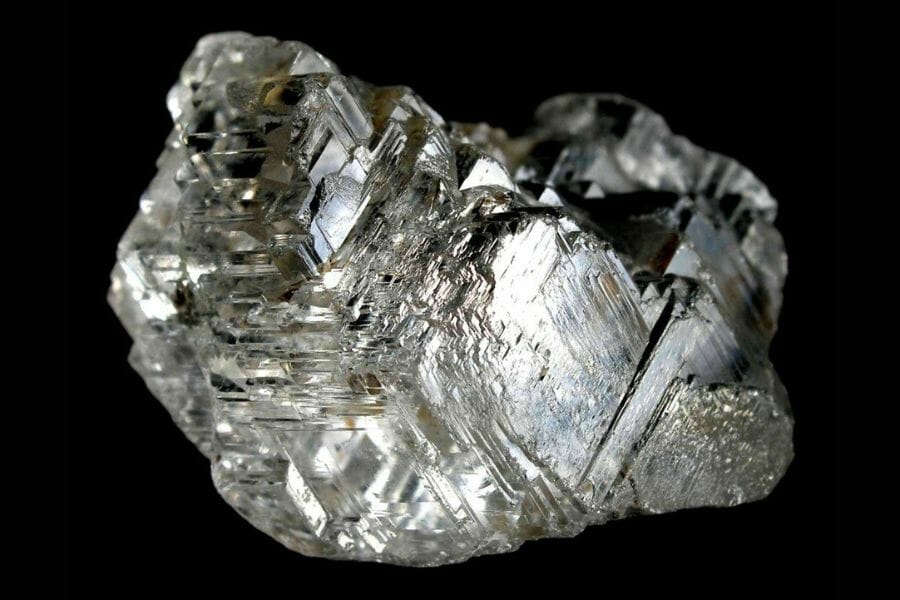
Alabandite is a rare and unique mineral that’s got a rich history, with its uses stretching back thousands of years.
One of the earliest known uses of Alabandite was in ancient Greece, where it was used in jewelry-making and decorative objects due to its metallic luster and unusual color. In more recent history, it was valued for its high manganese content and was used as an important ingredient in steel production during the 19th century.
Today, Alabandite is still prized for its unique appearance and is often sought after by mineral collectors and enthusiasts. It’s also used in the production of specialized alloys and other industrial applications, such as in the production of batteries.
Fun Fact
Did you know that Alabandite was first discovered in Alabanda, Turkey? With its familiar-sounding name, there's no doubt it was also where this mineral was named after.Where Alabandite is found
Alabandite is found in several places around the world, including Russia, U.S., and some parts of Asia. It’s a mineral that forms in mafic and ultramafic rocks and is also associated with sulfide deposits. In Russia, it’s commonly found in the Ural Mountains, while in the U.S., it’s found in Arizona, California, and New Mexico. Alabandite can also be found in Italy, Sweden, and other countries.
How you can identify an Alabandite
- Color: Alabandite has a silver metallic color, sometimes with a hint of gray and black. It has a brilliant luster, and its color tends to stay consistent in different lighting conditions.
- Hardness: The hardness of Alabandite varies. It’s usually around 5 on Mohs scale, which is relatively low. It’s soft enough to be scratched easily by a fingernail.
- Clarity: The clarity of Alabandite is typically opaque to sub-opaque. It’s not transparent and has limited light penetration.
- Refractive index: The refractive index of Alabandite is usually around 2.5, which is considered to be low to moderate. But this can vary depending on a sample’s chemical composition and other factors.
- Specific gravity: Alabandite’s specific gravity is approximately 4.7-5.0, which means it’s relatively dense. In fact, it’s almost as heavy as iron.
Pyrargyrite – Ag3SbS3
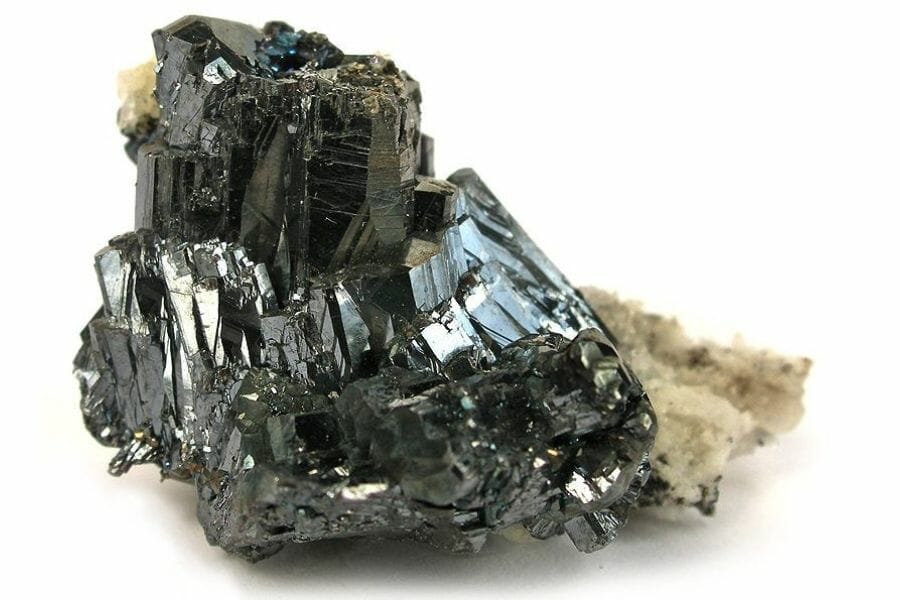
Pyrargyrite was first discovered in the early 19th century. Throughout history, it has been used in a variety of ways.
During the 19th century, it was commonly used in the production of silver compounds and as a source of silver. More recently, it has been used as an ornamental mineral.
Pyrargyrite is highly valued by mineral collectors and geologists. Its rarity and the fact that it’s a sulfosalt mineral also make it highly sought after. It’s also known for its interesting crystal formations and its ability to form in large, well-formed specimens.
Fun Fact With its interesting color, Pyrargyrite is also called the "Ruby Silver," because of its silver-gray color with a touch of deep red.
Where Pyrargyrite is found
Pyrargyrite is found in many silver mines around the world, including Russia, Australia, Mexico, and Chile. It’s often found alongside other silver-bearing minerals such as proustite and stephanite. The mineral occurs as prismatic or tabular crystals or as massive and granular deposits in hydrothermal veins.
How you can identify a Pyrargyrite
- Color: Pyrargyrite is known for its distinctive and intense red coloration with silver shimmer that makes it highly sought after by mineral collectors. It’s often mistaken for other minerals with a similar appearance, such as silver sulfides or cobaltian pyrite.
- Hardness: Pyrargyrite has a hardness of 2.5-3 on the Mohs scale, making it a relatively soft mineral. This is why it’s often not ideal for use in jewelry or other decorative applications, as it can be easily scratched or damaged.
- Clarity: Pyrargyrite has a high level of clarity— it has a transparent or translucent appearance because its composed of silver and antimony sulfide. Good quality ones are usually a gemmy or glassy crystal, with a high level of clarity and brightness.
- Refractive index: Pyrargyrite has a moderately low refractive index (around 2.0-2.3), which means that it doesn’t reflect light as strongly as other minerals.
- Specific gravity: Pyrargyrite has a specific gravity of 6.1-6.2. It’s relatively heavy compared to other minerals and can easily sink in water. The high specific gravity is due to its dense molecular structure and high silver content.
Acanthite – Ag2S
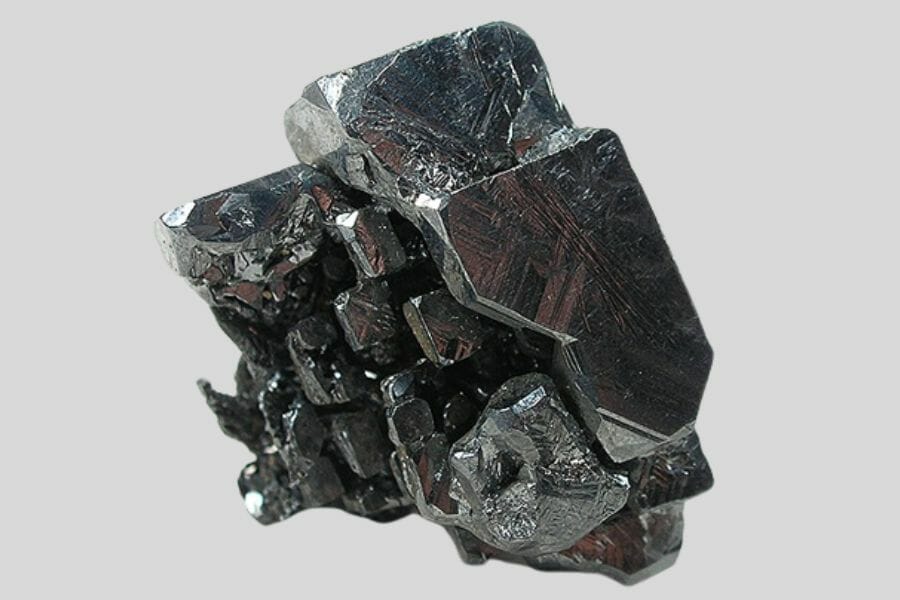
Acanthite is a valuable and fascinating mineral that has been used for thousands of years in many different ways. It was first discovered in the early 19th century and has been prized for its unique properties ever since.
Acanthite was often used as a source of silver in early metallurgical processes, and many of the world’s oldest silver mines used it as the main source of silver. The mineral’s unique luster and color also made it a popular choice for jewelry and other decorative objects, especially in ancient times.
Today, Acanthite is still valued for its unique properties, and is used in many industrial applications, including the production of silver and other metals, as well as in the creation of various electronic components.
Fun Fact The name "Acanthite" comes from the Greek word "akantha," which means "thorn," because of its sharp and spiky crystal formations. Adds beauty to this mineral, don't you think?
Where Acanthite is found
Acanthite can be found in several countries, including Mexico, Peru, Chile, Argentina, and Germany. It’s also been found in silver mines in the U.S. states of Nevada and Colorado. In some locations, it’s been found with other minerals like silver, pyrargyrite, and stephanite.
How you can identify an Acanthite
- Color: Acanthite’s color is typically a dark, metallic silver, sometimes with a slight tint of gray or black. Some specimens have been known to exhibit tarnish or discoloration, which can affect its appearance due to weathering or oxidation.
- Hardness: Acanthite has a hardness of 2 to 2.5 on Mohs scale. It’s softer than your fingernails, so it can easily be scratched or dented.
- Clarity: Acanthite’s clarity is usually opaque, meaning light can’t pass through it and objects behind it can’t be seen clearly. Despite being a metallic mineral, it can still have dull surfaces with a streaky or grainy texture.
- Refractive index: Acanthite’s refractive index ranges between 2.30 and 2.44, which is considered low. It’s because of this low index that the mineral has a dull luster, which is a result of the light being scattered rather than being reflected back.
- Specific gravity: Acanthite’s specific gravity is around 6.5-6.7, which makes it a relatively heavy mineral with a high density. This is due to its high metal content, specifically silver, which is a relatively dense metal.

